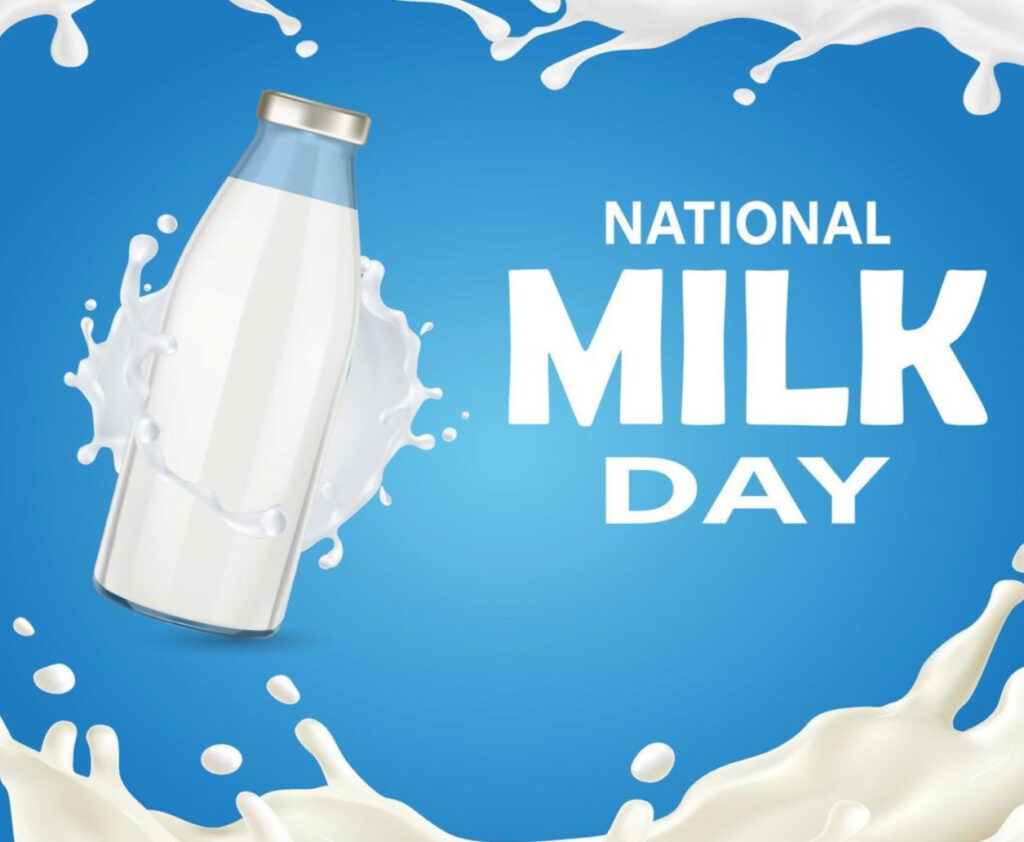National Milk Day is a day dedicated to honoring milk as one of the most essential and nutritious food items, as well as recognizing the vital role dairy farmers and the dairy industry play in our society. Celebrated annually, this day emphasizes the importance of milk in our daily lives and pays tribute to its contribution to health, sustainability, and economic development. In the United States, National Milk Day is observed on January 11, commemorating the delivery of the first bottled milk in the country in 1878.
Here, we explore the significance of National Milk Day, its history, the nutritional benefits of milk, and its impact on global and local communities.
The History of National Milk Day
Milk has been a staple in human diets for centuries, with its consumption dating back to the domestication of animals over 10,000 years ago. The introduction of bottled milk in the 19th century revolutionized its distribution, making it more accessible to people across the world. January 11, 1878, marked the first delivery of bottled milk in the United States, a significant milestone that laid the foundation for the modern dairy industry.
National Milk Day was established to honor this innovation and to highlight the contributions of dairy farmers who work tirelessly to provide this vital food product. Beyond the U.S., countries like India also celebrate Milk Day, emphasizing the global importance of milk in food security and nutrition.
The Nutritional Value of Milk
Milk is often regarded as a “complete food” because it contains a wide array of essential nutrients that support overall health. Here’s a closer look at its nutritional profile and benefits:
Rich Source of Calcium
Calcium is crucial for maintaining strong bones and teeth. Milk is one of the best dietary sources of calcium, helping prevent conditions like osteoporosis and ensuring proper skeletal development in children.
High-Quality Protein
Milk contains high-quality protein, which is essential for muscle repair, growth, and overall body function. Each glass of milk provides a balanced mix of essential amino acids.
Vitamins and Minerals
Milk is a rich source of vitamins and minerals, including:
•Vitamin D: Supports calcium absorption and bone health.
•Vitamin B12: Crucial for red blood cell formation and brain health.
•Potassium: Helps regulate blood pressure and maintain fluid balance.
Lactose: A Natural Sugar
Lactose, the natural sugar found in milk, provides a quick source of energy. While some people are lactose intolerant, lactose-free milk options make it possible for everyone to enjoy its benefits.
Hydration and Recovery
Milk is over 85% water, making it a great choice for hydration. Its protein and electrolyte content also make it an excellent recovery drink for athletes.
Milk’s Role in Global Nutrition
Milk plays a vital role in combating malnutrition worldwide. According to the Food and Agriculture Organization (FAO), milk and dairy products provide about 10% of the global population’s dietary energy supply. It is particularly important in developing countries, where access to diverse food sources may be limited.
Dairy programs in schools, for instance, have been instrumental in addressing child malnutrition by providing daily servings of milk, ensuring that children receive essential nutrients during their formative years.
The Dairy Industry and Its Economic Impression
The dairy industry is a cornerstone of agriculture and rural economies around the world. In the United States alone, dairy contributes billions of dollars to the economy annually and provides employment for millions, including farmers, processors, transporters, and retailers.
Supporting Rural Communities
Dairy farming sustains rural communities by creating jobs and fostering local economies. Family-owned farms are the backbone of the industry, with generations of farmers dedicated to producing high-quality milk.
Technological Advancements
Modern technology has transformed dairy farming, making it more efficient and sustainable. Innovations such as robotic milking machines, precision feeding systems, and improved breeding techniques have enhanced milk production while reducing environmental pressures.
Dairy Exports
The U.S. is a leading exporter of dairy products, including cheese, butter, and powdered milk. These exports support global food security and bolster the domestic economy.
Milk and Sustainability
Sustainability is a growing focus in the dairy industry, as producers work to balance productivity with environmental stewardship. Initiatives include reducing greenhouse gas emissions, improving water management, and adopting renewable energy sources.
Sustainable Farming Practices
Many dairy farms are implementing sustainable practices, such as:
•Manure management systems: Reducing methane emissions and converting waste into renewable energy.
•Improved feed efficiency: Lowering the carbon footprint of milk production.
Dairy and Climate Goals
Organizations like the U.S. Dairy Sustainability Alliance are working toward ambitious climate goals, including achieving net-zero carbon emissions by 2050. These efforts align with broader global sustainability targets.
Milk Alternatives and Consumer Choice
In recent years, plant-based milk alternatives—such as almond, soy, oat, and coconut milk—have gained popularity. While these options cater to diverse dietary preferences and needs, traditional dairy milk remains unmatched in its complete nutritional profile.
The rise of milk alternatives reflects the evolving landscape of consumer choice, where individuals seek products that align with their health, ethical, and environmental values. Importantly, both dairy and plant-based industries are striving to meet sustainability standards.
How to Celebrate National Milk Day
National Milk Day provides an opportunity to celebrate milk’s contributions to health and society. Here are a few ways to participate:
Support Local Dairy Farmers
Purchase milk and dairy products from local farms to support your community and ensure farmers receive fair compensation for their work.
Educate Yourself
Learn about the nutritional benefits of milk and the role of dairy in sustainable agriculture. Share this knowledge with friends and family to spread awareness.
Try a New Recipe
Incorporate milk into your meals by trying new recipes, such as creamy soups, smoothies, or baked goods. Use National Milk Day as an excuse to experiment in the kitchen.
Visit a Dairy Farm
Take a trip to a local dairy farm to learn about the milk production process firsthand. Many farms offer tours that showcase the dedication and care that goes into dairy farming.
Share on Social Media
Join the conversation online by sharing your favorite milk-based recipes, facts about dairy, or photos of how you’re celebrating the day. Use hashtags like #NationalMilkDay and #MilkMatters to connect with others.
National Milk Day is more than just a celebration of a beloved beverage—it’s a recognition of the hard work of dairy farmers, the economic and nutritional importance of milk, and the efforts to make the industry more sustainable. Whether you’re enjoying a glass of milk, supporting local farmers, or learning about its role in global nutrition, this day reminds us of milk’s enduring impact on our lives.
As we celebrate National Milk Day, let’s take a moment to appreciate the journey of milk—from farm to table—and the countless individuals who make it possible. By doing so, we honor the past, present, and future of this essential food and the industry that sustains it.
No comments yet.








